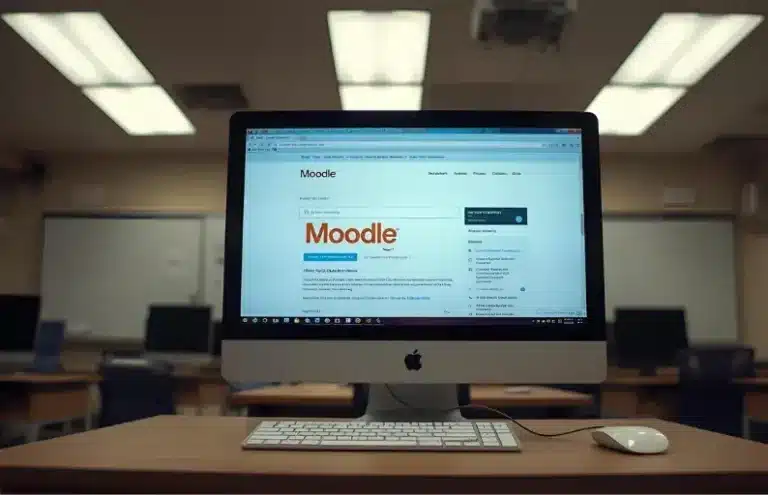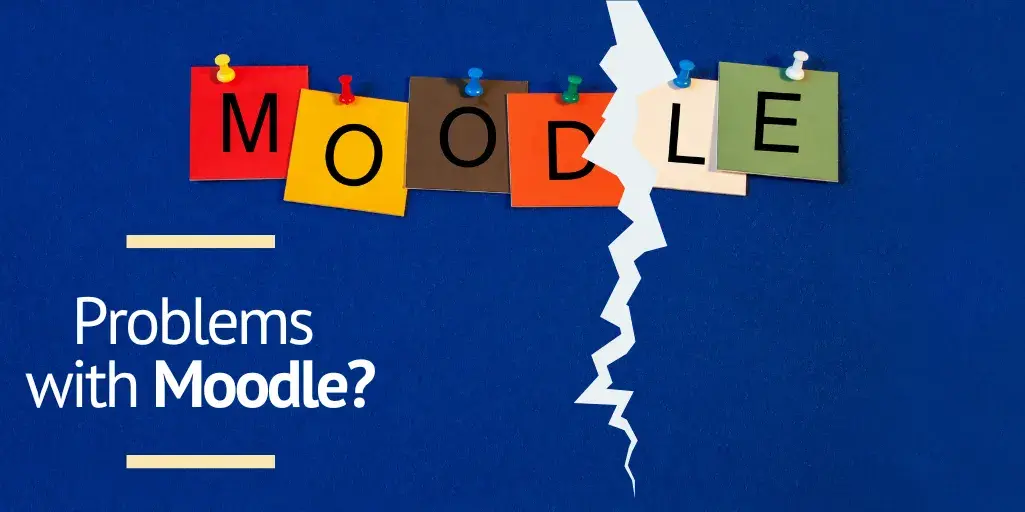Moodle is one of the most well-known and widely used online training platforms across the globe. Educational institutions, universities, training centres, and even companies have adopted it as a system to deliver their online courses. However, its popularity doesn’t necessarily mean it’s the best option for every project.
In fact, many users encounter technical barriers, usability issues, or unexpected costs after implementing it. The truth is, since Moodle is an open-source platform, it demands time, technical knowledge, and resources that not all organisations are willing—or able—to invest.
What can go wrong with Moodle and how can you fix it?

- Unintuitive interface: The interface isn’t designed for users without technical experience, which makes it harder to use.
- Solution: Provide initial training or invest in custom design.
- Complex updates: New versions can cause errors if not managed properly.
- Solution: Rely on specialised technical support or outsource maintenance.
- Hidden maintenance costs: Although the platform is free, customisation, hosting, and support lead to ongoing expenses.
- Solution: Make a full cost estimate before implementation.
- Steep learning curve: Both administrators and trainers need time to learn how to use it effectively.
- Solution: Plan for initial training and ongoing support for your team.
- Lack of official support: There is no centralised customer service.
- Solution: Rely on forums, community support, and certified third-party providers.
- Unattractive visual design: The default look can appear outdated or unprofessional.
- Solution: Invest in visual themes or hire designers to customise the interface.
- Compatibility issues: Some plugins don’t work well with certain versions or become obsolete.
- Solution: Maintain strict control of the development environment and run tests before upgrading.
Access issues

One of the most common drawbacks when using Moodle has to do with access failures to the platform. Learners, trainers, and administrators alike may face obstacles when trying to log in, whether due to technical issues or simple human error. What matters most is identifying the root cause early on, so the problem can be resolved quickly and work can continue smoothly.
With that in mind, here are the most common access-related problems in Moodle:
Username or password
- Cause: Incorrect or misconfigured credentials.
- Symptoms: Unable to log in, message saying “invalid credentials” or “non-existent user.”
- Quick solution:
- Check whether the user is entering their exact username (paying attention to upper/lower case).
- Reset the password using the “Forgotten your username or password?” option on the login screen.
- The administrator can check in the control panel whether the account is suspended, misspelled, or requires activation.
- In environments using external authentication (such as LDAP), it’s worth verifying that the external system is functioning properly.
Incorrect URL
- Cause: Misspelled or misconfigured web address.
- Symptoms: Page not found (404 error), redirection errors, or blank screens.
- Quick solution:
- Check that the URL entered is the current and official one for the virtual campus.
- Ensure the domain is correctly redirected and that the SSL certificate (https) is active.
- For self-hosted platforms, review the config.php file to confirm that paths and domains are correctly defined.
- It’s advisable to always use a simple, stable URL and avoid frequent changes that may confuse users.
Incompatible browser
- Cause: Use of outdated browsers or ones incompatible with certain Moodle features.
- Symptoms: Unresponsive buttons, menus not expanding, content not loading, or visual glitches.
- Quick solution:
- Always use up-to-date browsers like Google Chrome, Firefox, or Microsoft Edge in their latest versions.
- Avoid using Internet Explorer or lesser-known browsers that no longer receive proper support.
- Clear cache and cookies, as some display errors are caused by outdated temporary files.
- In organisations with non-technical users, it’s a good idea to recommend a standard browser and promote its use.
Ad blockers
- Cause: Interference from extensions or plugins that block scripts or web elements.
- Symptoms: Sections of the platform not loading, video players not displaying, upload errors, or features disappearing without an obvious reason.
- Quick solution:
- Temporarily disable the ad blocker when accessing Moodle, or add the platform to the whitelist of exceptions.
- window or in a different browser without active extensions.
- Notify users in advance if the virtual campus requires certain scripts or pop-ups to be allowed.
Content display issues

One of the most frustrating aspects for Moodle users is that sometimes content doesn’t display properly, gets cut off, doesn’t load, or simply doesn’t appear at all. These kinds of issues directly disrupt the learning process and create confusion for learners, trainers, and administrators alike—on top of wasting valuable time.
Generally, these display errors are linked to browser settings, unnoticed technical faults, or even poor integration of certain resources within the platform. Below, we highlight the most common content display issues.
Blocked cookies
- Cause: Browser settings that prevent essential cookies from being saved.
- Symptoms: Images or videos not loading, error messages when accessing activities, unexpected logouts, or an inability to complete certain tasks.
- Quick solution:
- Enable cookies for the domain where Moodle is hosted via the browser settings.
- Check that extreme privacy extensions aren’t in use, and avoid browsers with automatic blocking (like Brave or Firefox in strict mode).
- For institutional environments, add the virtual campus URL to the list of trusted or exception sites.
- Provide a quick guide with step-by-step instructions to help users enable cookies.
Outdated cache
- Cause: The browser stores older versions of files or pages that have since changed on the server.
- Symptoms: Recent changes to the platform not appearing, unresponsive menus, broken layout, or activities not updating properly.
- Quick solution:
- Force a browser refresh (Ctrl + F5 or Cmd + Shift + R).
- Manually clear the cache via the browser settings.
- In environments where content or design changes are frequent, inform users how to properly clear their cache.
- The Moodle administrator can purge the system cache from the admin panel to prevent global errors.
Misconfigured permissions
- Cause: Restrictions in the permissions assigned to user roles within Moodle.
- Symptoms: Files, videos or activities not loading, “access denied” messages, users unable to see content that should be available.
- Quick solution:
- Check the roles assigned to the user within the specific course or activity.
- Review resource visibility settings (e.g. whether content is hidden from certain roles).
- Use the “Check permissions” tool in the admin panel to see what a user can or cannot do.
- Set clear rules and use role templates to avoid errors when customising permissions.
Database issues

The database is the core that supports the entire functioning of Moodle: it stores users, courses, activities, grades, and settings. That’s why, when something goes wrong at the database level, the impact can be severe: from loading errors to a complete platform crash.
These kinds of issues tend to occur more frequently in Moodle systems managed independently by each organisation. Since the school, company, or any institution using the platform is fully responsible for the technical side, they must ensure everything is running smoothly. If proper maintenance isn’t carried out or the environment isn’t optimised, problems can be difficult to diagnose and even harder to fix without qualified technical support.
DB connection error
- Cause: Failure in communication between Moodle and its database (MySQL, MariaDB, etc.).
- Symptoms: Error message “Error: Database connection failed,” blank screen, or total inability to load the platform.
- Quick solution:
- Check that the database server is active and has sufficient responsiveness.
- Verify in the config.php file that the connection details (host, username, password, database name) are correct.
- Ensure the database user has the necessary permissions to access and modify the database.
- Review the error_log files for more technical details about the failure.
Server misconfiguration
- Cause: Poorly adjusted server parameters or incompatibility with Moodle’s technical requirements.
- Symptoms: Slow campus loading times, random errors when saving changes or accessing courses, messages like “server not responding” or failures in running scheduled tasks.
- Quick solution:
- Check that the server meets the minimum requirements for the installed Moodle version (PHP, MySQL/MariaDB, required extensions, etc.).
- Use diagnostic tools such as Moodle’s environment check report (/admin/environment.php) to detect incompatibilities.
- If in-house technical support is not available, it’s best to choose a provider that offers an environment optimised specifically for e-learning platforms.
Installation or upgrade issues

Getting Moodle up and running—or upgrading it—can turn into a real headache, especially if you’re doing it on your own server and lack technical experience. While it may seem like just another routine task, the reality is that many administrators encounter unexpected errors, long waiting times, or installations that freeze for no apparent reason.
These issues are often linked to server configuration problems, lack of resources, or poor technical management.
In this section, we’ll go over the most common problems that typically arise when installing or upgrading Moodle.
PHP time limits (max_execution_time)
- Cause: PHP script execution time limit set too low.
- Symptoms: Installations stopping midway, 500 errors, messages like “maximum execution time exceeded,” or blank pages after starting the upgrade.
- Quick solution:
- Increase the max_execution_time value in the php.ini file to at least 300 seconds during the installation or upgrade process.
- In shared hosting environments, contact the provider to request a temporary change.
- Once the upgrade is complete, the original value can be restored for added security.
Prerequisites (PHP version, modules, memory)
- Cause: The server does not meet the minimum technical requirements for the version of Moodle being installed or upgraded.
- Symptoms: Errors during installation, warning screens indicating missing extensions, messages such as “incompatible PHP version,” or installation freezing entirely.
- Quick solution:
- Check Moodle’s official system requirements before installing or upgrading.
- Verify that the installed PHP version is compatible with the Moodle version you intend to use (e.g. PHP 8.1 for Moodle 4.2).
- Ensure the required modules are enabled (intl, xmlrpc, mbstring, curl, zip, among others).
- Increase the memory_limit parameter to at least 256M to prevent memory-related errors.
Desventajas de Moodle

Many training centres, companies, and organisations run into difficulties because Moodle doesn’t work as they expected.
Ultimately, choosing the right elearning platform involves many factors to consider, and just because it’s one of the most widely used tools doesn’t mean it’s the best fit for every situation.
Below, we go over the main disadvantages of Moodle as frequently reported by users themselves.
Relative “free” cost
- Not everything is free: While Moodle is marketed as free because it’s open source, in practice, implementing it involves notable expenses.
- Customisation costs: Adapting the platform to match your corporate branding or adding specific features usually requires specialised developers.
- Required infrastructure: You’ll need to pay for a server (often high-performance) and a custom domain to ensure the platform runs smoothly.
- Reliance on third-party providers: In most cases, organisations must turn to external companies for installation, configuration, updates, and technical support.
- Budget impact: When you add up customisation, hosting, domain, and ongoing maintenance, the total cost can be considerable—often much higher than initially expected.
Expensive download, installation, and setup
- Complex technical process: Although downloading Moodle is straightforward, configuring it correctly requires advanced knowledge of servers, databases, and PHP.
- Implementation time: Setting up and preparing the environment can take days—or even weeks—if starting from scratch.
- Infrastructure requirements: A suitable server, SSL certificates, a custom domain, and technical resources are all needed to ensure stable operation.
- Reliance on specialised personnel: Most organisations must turn to IT specialists or external providers to carry out the installation and initial setup.
- Accumulated cost: Between infrastructure, time investment, and skilled labour, the initial setup can represent a significant expense—before even beginning to use the platform, as we've seen above.
No free trial available
- No immediate access: Moodle doesn’t offer a ready-to-use online free trial; the only way to test it is by installing it yourself or using limited third-party demos.
- Complex initial process: Before you can explore it, you need to download it, configure a server, install the system, and perform basic setup—all of which require technical knowledge.
- Time and resources required: Even for a simple evaluation, you’ll need to invest time, infrastructure, and possibly external assistance.
- Comparison with other options: Other platforms often offer instant access to free trials without the need for installation, making decision-making easier.
Usability far from user experience standards
- Steep learning curve: Moodle takes time to learn, especially for administrators without programming knowledge or technical experience.
- Unintuitive interface: The menu structure, options, and settings can be confusing, with features that are hard to find or scattered throughout.
- Impact on learners and trainers: While some administrators may adapt, many trainers and learners find the environment unfriendly and uninspiring.
- Prolonged adaptation time: Daily setup and management can take up hours that should be dedicated to content creation or learner support.
- Comparison with more modern environments: Other platforms prioritise visual simplicity and usability, reducing the need for technical training to get started.
Courses and manuals for everything
- Frequent official training: Moodle’s own website offers free one-month courses twice a year to help users learn how to use the platform—already a sign of its complexity.
- Manuals for every user type: While there are guides for administrators, trainers, and learners, the high level of customisation means each installation is different and may require bespoke instructions.
- Updates that require retraining: With each new version, part of what users have learned may become outdated, forcing them to repeat training processes.
- Extra burden on trainers: Time spent learning and adapting to the tool reduces time available to prepare materials and support learners.
- Impact on efficiency: A platform that demands constant learning can slow down adoption and affect the overall quality of training.
Low security and risky updates
- Server dependency: If the server hosting the platform experiences downtime or internet connection failures, access to courses and materials is interrupted.
- Frequent updates: Moodle receives regular updates which, although necessary, can cause incompatibilities or errors in functionality.
- Known vulnerabilities: As an open-source and widely used platform, Moodle can become a target for attacks if it isn’t kept up to date and properly configured.
- Slow and complex solutions: Some security issues require lengthy technical interventions, leaving the platform potentially exposed for days.
- Increased risk with non-specialist staff: Without a technical team to manage patches and backups, the margin for error and vulnerability is much greater.
Demands significant time and effort
- Complex initial installation and setup: Getting the platform up and running involves several technical steps—downloading, installation, server configuration, and customisation—all of which take time and require specific expertise.
- Ongoing maintenance: Fixing issues, applying updates, and adjusting settings are tasks that require continuous attention.
- Managing technical problems: Every error or malfunction requires manual intervention, which can delay the delivery of courses and materials.
- Impact on productivity: The more time spent on technical matters, the less time is available to create and improve training content.
- Greater reliance on external support: Without an in-house technical team, it’s likely you’ll need to hire specialised help on a regular basis.
Support and maintenance on your own
- Community support as the main resource: In most cases, help is obtained through forums and collaborative documentation, which can slow down the resolution of urgent issues.
- No direct technical assistance: There’s no official team to contact via phone or email for immediate problem-solving.
- Ongoing maintenance: The platform requires regular updates, security checks, and technical adjustments.
- Need for technical knowledge: Without a specialised in-house profile, it will be necessary to hire a developer or external provider for these tasks.
- Hidden costs: Although the software itself is free, the expense of professional support and maintenance can significantly increase the overall training budget.
When is it worth getting professional support?

If you’re not an e-learning expert, your technical level isn’t very high, you’ve had frustrating experiences with Moodle or another platform, or you’re simply not satisfied with how it’s working, professional support becomes essential.
Choosing the right elearning platform is crucial, and having specialised support can be the key difference between a project that runs efficiently and one that gets stuck in technical or administrative problems.
You might be interested in another open-source platform—or perhaps a commercial SaaS solution.
The latter are especially convenient because they’re hosted in the cloud, not on a local server, and offer major advantages in terms of security and ease of use.
For those looking for simpler options with built-in support, platforms like evolCampus offer a smoother experience and ongoing technical assistance, reducing the need to handle installation and maintenance yourself.
Having specialised support brings several advantages:
- Optimised user experience: Administrators, trainers, and learners access an intuitive and fully functional platform from day one.
- Issue prevention and resolution: From configuration errors to database crashes, the support team can anticipate and resolve problems quickly.
- Saving time and resources: With no need to handle installations, updates, or manual maintenance, your team can focus on creating content and supporting users.
- Security and stability: Server management, updates, and data protection are all overseen, reducing risks and vulnerabilities.
- Smooth transition from other platforms: For those coming from Moodle or another LMS, professional support makes it easier to migrate content and users without disruption.
- Ongoing support: Support doesn’t end with installation—continuous assistance ensures the platform runs smoothly and is used to its full potential.
Final tips to solve your Moodle issues
- Take time to explore and evaluate other tools.
- Choose a platform that truly meets your needs and fits your project based on your goals, skills, and available time.
- Speak with a provider who works daily to deliver an elearning platform that is complete, easy to use, and flexibly priced.
- Consider alternatives where cost isn’t the main factor—but rather the service and quality.
